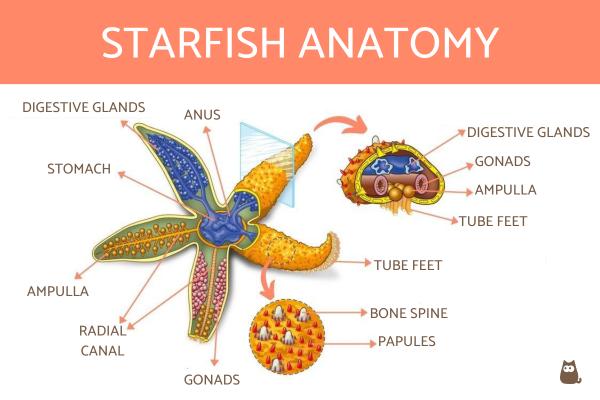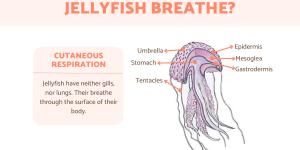How Do Starfish Breathe? - Underwater and Out of Water!


Starfish are fascinating sea creatures full of mysteries. In this AnimalWised article, we're going to explain how starfish breathe.
We'll go through their unique anatomy and explain how these sea stars breathe underwater and above water. Keep reading to learn more!
What are starfish?
Starfish (Asteroidea) are marine invertebrates found from the intertidal zone down to the abyssal depths of 6,000m and below. They normally have a central disc and five arms, giving them their infamous star shape. Nevertheless, there are 2,000 known species of starfish, and so, they vary from habitats to size and colours.
The average lifespan of a starfish is 35 years. These sea stars are carnivores and feed on coral, sponges, clams, oysters, sand dollars, and mussels. They do this by first extending their stomach out of their mouth and over the digestible parts of its prey. The prey's tissue is partially digested externally before the soup-like "chowder" produced is drawn back into the starfish's 10 digestive glands. Learn more in our article about what starfish eat.
And so, you see, although these sea creatures are beautiful and seem to merely be resting on a rock or the sand, there's actually a lot more to their existence and survival. One of their many mysteries is how they breathe. In order to answer that question, let's take a look at their anatomy.
Starfish Anatomy
Starfish are made up of a central disk divided into five equal parts. From each of them, an arm or radius ends in a point, giving them their characteristic star shape. However, some species have more than five arms, such as the impressive sun star species (Heliaster helianthus). Normally, they are covered by a bony skeleton, made up of small pieces or ossicles that are located just below their skin.
This way, their body is flattened and has radial symmetry in the lower part is the mouth, right in the center of their body. Therefore, to eat they go on top of their prey or food. The ambulacral areas that go towards the tip of each arm start from their mouth. Each of them is crossed by rows of tube feet. These are part of the internal ambulatory apparatus, a hydraulic structure that helps them move.
In the upper or aboral part of the starfish we find their anus, also in the central disk. Normally, the aboral face is covered with bony spines, which may or may not be crushed. At its base, there are pedicellars or valves that help clean the surface of the body and protect soft structures that protrude between the ossicles: the dermal papules or gills. These are the key to understanding how starfish breathe.
Lastly, in the area surrounding the anus there are also gonopores, small holes that serve to release their gametes during sexual reproduction. Want to learn more? Don't forget to check out our article about starfish reproduction.

How do starfish breathe underwater?
Starfish breathe through their papules or skin gills on the surface of their body, absorbing the oxygen directly from the seawater.
To further elaborate on how they do this, starfish have a coelom (main body cavity) whose walls walls are lined by cilia or hairs that move the fluid throughout the body, bathing the internal organs. It communicates with the outside thanks to some soft bumps that appear on the surface of the body: the papules.
The wall of the papules is very thin and this is where gas exchange takes place. Oxygen (O2), which more abundant in seawater, enters the interior of the animal's body by diffusion. Carbon dioxide (CO2), more abundant in the interior of the star, flows by diffusion into seawater along with other wastes, such as ammonia (NH3). Thus, gases and small substances move from where they are most abundant to where they are least.
Therefore, the coelom not only functions as your respiratory system, but also as your excretory system. The liquid in the coelom collects the waste produced by internal organs, such as CO2. In return, it provides them with oxygen and small nutrients that diffuse into the papules. This is how starfish breathe and how they clean themselves.
In addition, these invertebrate animals can breathe through their aquifer or ambulacral apparatus, an internal cavity that only appears in echinoderms. It is a system of channels or hydraulic apparatus that ends in the tube feet, some projections that fill and empty of water. They work as a kind of suction cups, allowing the movement of the animal. In a very small amount, O2 can enter and CO2 exit through them.
How do starfish breathe out of water?
They don't. Starfish cannot breathe out of water, this is why it's recommended not to take them out of the water for more than 20 seconds as most species of starfish can only hold their breath for 30 seconds. Taking them out of water will kill them as they will not be able to absorb oxygen and will die form intoxication of carbon dioxide or monoxide.
If you want to read similar articles to How Do Starfish Breathe? - Underwater and Out of Water!, we recommend you visit our Facts about the animal kingdom category.
Hickman, CP et al (2009): Comprehensive Principles of Zoology . McGraw-Hill, Madrid.






